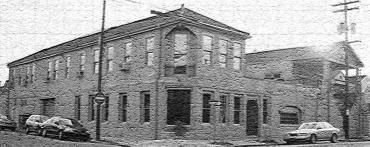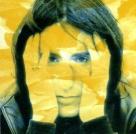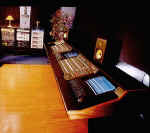
Click
on the Music Gear Review banner above to return to the main page

Trent Reznor's Funeral Home Studio
by
Christopher Buttner
Even when the sun is shining and the temperatures are a pleasant balmy
tropical, yet unusually warm 80 degrees for January, New Orleans carries a
historic air of captivating Gothic, Vampire and Voodoo intrigue and
mystery. I can't think of a better city from which to report this
next story.
To his fans, Trent Reznor is recognized as the frontman, lead singer of
the multi-platinum selling, Grammy award-winning, Nine Inch Nails. What
many probably don't know is Trent is also a production wunderkind for
numerous other platinum bands and artists, best known act being Marilyn
Manson, as well as movie soundtracks, including Oliver Stone's 'Natural
Born Killers', David Lynch's 'Lost Highway,' and Howard Stern's 'Private
Parts.' In April of 1995, Trent moved his rapidly blossoming record
label and production empire into a massive 17,000 square foot, 85+ year
old funeral home in the uptown area of New Orleans. Known as Nothing
Studios, the ominous charcoal gray edifice, with striking pitch black
one-way windows, seems to loom over every other structure in the
neighborhood from blocks away. As I approach, the building continually
takes on an enveloping personality, until when I am standing at its gated
entrance, even before I set foot over the threshold into its interior, the
building almost obscures, if not absorbs, the sun, blue sky, and even the
wind.
The architectural statement the immaculate building makes is somewhere
between "gentrified Munsters" and "Addams Family meets
Better Funeral Homes and Gardens."
I ring the bell at the wrought iron gate and wait to be approved for entry
as I am scrutinized by eyes behind numerous security cameras mounted every
corner of the building. The buzzer sounds as the dead-bolt is
electronically released and I enter into the 'holding area' between the
gate and the front door. A second buzzer sounds
after the gate closes behind me and I enter Mr. Reznor's lair.

The charcoal gray walls and black one-way windows, black trim, drapes and
carpet are dramatically offset by the vividly happy Blueberry color of the
iMac computers on several of the desks. Even with the dark interior
decorations, I am amazed at the amount of light that enters the building
through the darkened windows. One wonders DO THE ROOMS in such
a darkly appointed building get darker when one
turns on the lights?
My eyes take a minute to adjust to the darkness as everyone is reduced to
rapidly moving back-lit silhouettes against the intense light coming
through the one-way windows. After a few seconds I realize I am in
the foyer, at the base of a massive, double-wide stair case that probably
once led to a large viewing room, where over
85 years, thousands of mortals were laid out before grieving loved ones.
I find out later that this area is now home to some two dozen classic
video and pinball machines. The stair case is so wide, I almost
expect the stairs to open on a massive hinge, revealing Spot, the
Munster's pet Dragon, breathing fire and brimstone.
Suddenly I feel the presence of two large four-legged bodies in my
personal space as the front door snaps shut. As I look down into the
darkness, I can only see the glint of two pairs of dark eyes staring up at
me from waist level. I feel the warm breath of the Omen-like canines
on my abdomen as their wagging tails sweep the air,
signifying I am approved by this second stage of security. Ellie the
Labrador and Ethel, a Lab/Shepherd mix, both lovingly referred to by
Nothing staff as 'coffee table wide', appear to be thoroughly trained to
pin one down and lick them into submission should the need arise. Reznor
loves animals, so Nothing Studios is an animal-friendly
environment. Trent's beloved Weimaraner Daisy May isn't around this
particular afternoon; she's clearly off duty leaving her associates to
defend the real estate.
Nothing Studios manager (engineer, assistant engineer, tech, etc.), Brian
Pollack emerges from the darkness to introduce himself and shake my hand.
I inquire about the age and history of the building and he states,
"We're not sure if it's a turn-of-the-century building, but we know
it dates back to the early 1900's. When we
moved in we found funeral receipts and canceled checks from as far back as
1914 and 1915."
"Any ghost or poltergeist activity since Trent took up
residence?", I inquire.
Brian rolls his eyes and smiles. "No, nothing. No sightings by
anyone."
I am then pointed to an interesting artifact that makes me wonder if the
Christmas Spirit even bothers to visit Nothing Studios.
The front door through which I just entered was previously the front door
of Roman Polanski and Sharon Tate's home on Cielo Drive, in Los Angeles.
Yes, the same home where the infamous 'Tate Murders' took place on August
9, 1969, at the hands of Charles Manson family members Tex Watson,
Patricia Krenwinkel, Susan Atkins and Linda Kasabian. When police
discovered the grisly murder scene it was on
the lower half of this very door that the officers saw the word
"PIG" scrawled with the blood of the murder victims.
In 1992, after looking at 15 houses in one day, Trent signed the lease on
the infamous 'Charlie Manson' Tate house to record 'The Downward Spiral'
before being informed of its bloody history. When he album was
completed, the owner of the house moved forward with his plans for
demolition, but not before Trent requested, and received
permission, to keep the front door.
I close my eyes and place my hand on the door for a few seconds expecting
to pick-up some kind of a paranormal vibe to the horror of what this
artifact must have witnessed over 30 years ago. Feeling nothing, I
open my eyes to see Brian smirking at me. We both roll our eyes and
shrug our shoulders. I nervously laugh at how
ridiculous I must have looked and then we begin the tour of Trent's
incredible, platinum record-adorned, technological labyrinth.
Each portal leads deeper and deeper into the high-tech catacombs of the
sprawling facility. Room after equipment-stacked room features
numerous guitars, keyboards, amplifiers, miles of cable, effects, and
racks-upon-racks of equipment. It's as if in the five years between
the five-time platinum selling 'The Downward Spiral' and 1999's
23-song 'The Fragile', Trent has employed a full-time person to shop for
two of everything, from every major music store, in every major city.
click to
enlarge

I am informed the studio staff has totally lost count of the number of
Mackie mixers that reside at Nothing Studios. On our walk through
the various Nine Inch Nails band member project rooms, we quickly count
three 32*8 Bus consoles, one with a 24*8 extender in a sidecar. Numerous
1604 and 1202 compact mixers dot the landscape of every studio environment
we pass through. While it's pointed out they're used for everything
from keyboard mixing, input expansion for monster consoles, submixing and
final mixing every where in the building, I am also advised, they
might be breeding since more and more of them seem to turn up every month.
I wonder if a 1604 might be being used at the receptionist's desk to route
incoming calls.
Since 'The Fragile' was released in September of 1999, the Nothing
Studios' staff of about ten full-time employees ramped up the facility to
open for commercial business in early 2000. In the five years since
it was purchased, the building has been Trent's private 'Funeral Home
Studio' where Marilyn Manson's Antichrist Superstar was
recorded and produced, as well as Trent's latest epic. Purchased in
April of 1995, Brian points out, "We had Studio A up and running and
we were off and mixing by July of the same year. Studio B came on
line months and months after that."

Studio B, the latest and greatest addition to Nothing Studios, is replete
with the consistent decorum of charcoal gray walls, black trim and molding
and carpet, and black sound absorbing drapes hang from wrought iron
curtain rods. Two colorful Blueberry Macintosh G3 CPUs, in the
center of the room, again stand out in a sharp contrast under the clarity
of halogen lights.
An expansive Argosy desk houses the two new Mackie Digital 8 Bus consoles,
purchased and installed in April of 1999. The desk is incredibly
stream-lined with the two monitors mounted down into the Argosy, behind -
you guessed it - black glass. Brian advises me, "Trent is full
on to learn anything new and he was the one who said,
'Let's get the Mackie D8Bs,' after checking out all of the specs. He
has gotten to the point where he delegates a lot of responsibility, as
opposed to being hands on on everything, and it's really his ears that do
a lot of the work in Studio B. Mainly he does his work in Studio A,
but there are times when he will come back to Studio B and use it as his
writing room and do some singing."
Brian continues, "In fact when the D8Bs first showed up, I was on
vacation and Trent was the first person to get them up and running. When I
came back he was like, 'Look how easy these things are to use, you can
just press this and it'll do that, and if you do that, it'll do this.'
He was ramped up and working on these things in no time."
"There was such short leaning curve on the D8B it really surprised me
as to how easy they are to learn," Brian notes. "It was
just a question of me sitting down with some signal running through the
console, a bit of scanning the interface, and suddenly I'm saying, 'oh,
okay, that's easy enough.' I really didn't have to get into the
board too heavy to really understand it."
Brian then spent a week of sixteen-plus hour days making the room ready in
anticipation of Studio B's first outside clients. The group Porter
Ricks, a collaboration of ambient maestro Thomas Köner and beatmeister
Andy Mellwig, were the first outside artists to visit Nothing Studios and
mix their new single, 'The Day the World Went Away' on the Mackie D8Bs.
Brian points out that the boards are networked together so they act as one
console with 48 digital inputs and 48 analog inputs. The D8Bs were
called upon for the remixing of 'Ten Miles High', which appears on the
vinyl release of 'The Fragile', as well as the UK single release for
'Complication.'
All of the digital sequencing for 'The Fragile' was handled on the
D8Bs, as well. Brian points outs, "Bob Ezrin did all of
the digital sequencing on the D8Bs for 'The Fragile' here in this
room."
The D8Bs are fed automation moves from a multitude of computers, all of
which are running ProTools and Logic, from the band member's individual
project studios. Song sections or remixes are started in any of the
upstairs studios and then transferred to the D8Bs for collaborative mixing
and print down.
Continuing, Brian states, "There was one mix I had done on both of
the D8Bs, and there was a lot of timecode. After listening to it I
wanted to come back a few days later and do a few fixes. I just
reloaded the settings and had everything back to where I had exactly left
it off in a second. I got the perfect sound instantly and then it
was incredibly fast and easy to make the changes."
"Instant recall, instant everything," Brain states as a
few of the D8B's best assets. "In Studio A, we have the SSL
4000G Plus, a great board, it's a favorite of mine, but with the D8B, if
you want to call something up, it's just one button and you can call up
and reset whole board. Once we got the synch card installed and with
the ease of the interface with the computers, they have been flawless.
A breeze. Plus, they sound great. It's one thing to be easy to
use, but if they don't sound good, what's the point?"
"With the gates and compressors on each channel, and even little
features like switching between a two track A and B and main and near
field switchability, even the way the mix system works, it's up there with
a console that costs hundreds of thousands of dollars."
I ponder, Hmmm. That could be another great business venture for
Trent... Maybe he could use the savings to start a magazine
called, 'Funeral Home Recording?'
Click Here To Return To The Music Gear Review
Home Page
|